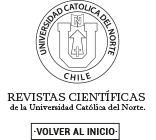Cabis, guacas-fortalezas y el control incaico del valle de Aconcagua
DOI:
https://doi.org/10.22199/S07181043.1999.0018.00017Abstract
Se postula a partir de información arqueológica e histórica temprana que en el Período Agroalfarero Tardío preincaico, la población nativa del valle de Aconcagua se encontraba agrupada en torno a Cabis, teniendo a la vista un cerro sagrado —cerro Tren-Tren—3 y al mando de un cacique principal. El control incaico del valle se habría efectuado mediante la apropiación del mencionado cerro y la construcción en el lugar de una guaca-fortaleza. Se ejemplifica con los casos del cerro Mercachas y el dominio del Cabi de Curimón en las tierras altas y, el de cerro Mauco y la intervención del Cabi de Puchun en las tierras bajas.
Abstract
Based on early historical and archaeological information, we State that in the pre-incaic Late Pottery-agricultural Period, the native population of the Aconcagua valley was grouped around a Cabi, having a sacred hill (Tren-Tren hill) in its range of sight, and was commanded by a main cacique. The incaic control of the valley could have taken place by means of the appropriation of the mentioned hill and the construction of a guacafortress at this location. Examples of it are the cases of Mercachas hill and the dominion on the Cabi of Curimón in te highlands, and the case of cerro Mauco and the intervention of the Cabi of Puchun in the lowlands.
Downloads
Downloads
Published
Issue
Section
License

All works published in Revista Estudios Atacameños (ISSN on line:0718-1043) Revista Estudios Atacameños Creative Commons International 4.0 attribution (CC BY 4.0) licence.
Authors remain the owners of their work and may republish their articles elsewhere without having to request permission, as long as they indicate that the work was originally published in Revista Estudios Atacameños (ISSN on liine:0718-1043).












